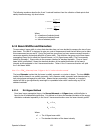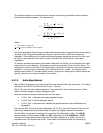
becomes better and vice versa. The Correlation gives a relative feeling for how well the data matches
a Gaussian surface.
However, this result is relative, not absolute. A result of 0.8 tells us the data is a better Gaussian shape
than a result of 0.7 and a worse Gaussian than 0.9, but it does not tell us how much more or less. A
change from 0.85 to 0.9 tells us there was an improvement but does not tell how much.
The definition of the Correlation can be seen in the equation below. Dividing it by the volume of the
data normalizes the relative error, |Z-S|. This allows relative comparisons of the correlation value
between different samples and beams. The relative error has a potential range of zero to infinity.
Therefore, the correlation has a potential range of minus infinity to one. However, we have found the
practical range is between zero and one. If the correlation is less than zero, then the beam is obviously
not Gaussian.
G
ZS
Z
c
=−
−
∑
∑
1
Where:
G
c
= Gaussian correlation, -1<
G
c
< 1.
Z
= pixel intensity.
S
= Gaussian surface intensity.
6.18 Top Hat
The Top Hat computations quantify laser beams that have a flat topped energy distribution with
steeply sloped sides. The Top Hat results provide the Mean, Standard Deviation, and Minimum and
Maximum energy density in a defined area on the beam’s energy profile. A Top Hat Factor value is
computed to indicate the overall quality of the Top Hat energy distribution. An Effective Area and
Effective Diameter results are also computed to indicate the working area of the beam.
In general most Top Hat measurements should utilize the Percent of Peak method for determining a clip
level.
The Top Hat edit control allows you to measure a Top Hat beam in three different ways.
1. Data: Only pixels with intensity levels above the clip level will be use to compute the Top Hat
results. If an aperture is present it will further limit the analysis to the pixels inside the aperture.
2. Area Aperture: The Top Hat Area Aperture selection is intended to be used to analyze the data
within a specific region lying on the upper surface of a Top Hat beam. Use a Drawn Aperture
to isolate regions of the beam and compute results over the entire area enclosed by the aperture,
(the clip level is ignored for all but the Effective Area and Diameter results). While this method is
intended for use with a Drawn Aperture, it will however work with no aperture and with an
Auto aperture, see the notice below.
3. Line Aperture: The Top Hat Line Aperture is intended to be used to analyze the data lying
along the axes of a Drawn Aperture. As in Area Aperture above this should be limited to
regions lying on the upper surface of the Top Hat beam. Except for Top Hat Factor a separate
result will be computed for each axis of the aperture. Use a Drawn Aperture to isolate regions
of the beam and compute results over only the orthogonal axes of the aperture, (the clip level is
ignored for all but the Effective Area and Diameter results). This method is intended for use with
a Drawn Aperture, however it will work with no aperture and with an Auto aperture, see the
notice below.
Operator’s Manual LBA-PC
138


















